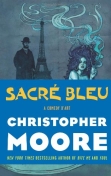BKMT READING GUIDES
Sacre Bleu: A Comedy d'Art
by Christopher Moore
Hardcover : 416 pages
9 clubs reading this now
11 members have read this book
“Christopher Moore is a very sick man, in the very best sense of that word.”
—Carl Hiassen
“[Moore’s novels] deftly blend surreal, occult, and even science-fiction doings with laugh-out-loud satire of contemporary culture.”
—Washington Post
“If there’s a funnier writer out ...
Introduction
“Christopher Moore is a very sick man, in the very best sense of that word.”
—Carl Hiassen
“[Moore’s novels] deftly blend surreal, occult, and even science-fiction doings with laugh-out-loud satire of contemporary culture.”
—Washington Post
“If there’s a funnier writer out there, step forward.”
—Playboy
Absolutely nothing is sacred to Christopher Moore. The phenomenally popular, New York Times bestselling satirist whom the Atlanta Journal-Constitution calls, “Stephen King with a whoopee cushion and a double-espresso imagination” has already lampooned Shakespeare, San Francisco vampires, marine biologists, Death…even Jesus Christ and Santa Claus! Now, in his latest masterpiece, Sacré Bleu, the immortal Moore takes on the Great French Masters. A magnificent “Comedy d’Art” from the author of Lamb, Fool, and Bite Me, Moore’s Sacré Bleu is part mystery, part history (sort of), part love story, and wholly hilarious as it follows a young baker-painter as he joins the dapper Henri Toulouse-Lautrec on a quest to unravel the mystery behind the supposed “suicide” of Vincent van Gogh.
Editorial Review
Amazon Exclusive: Christopher Moore on Writing Sacre Bleu
 I suppose it started when I learned the circumstances of the suicide of Vincent van Gogh; how he had finished a painting, then walked into a corn field and shot himself, and not in the manner one thinks of a suicide. He shot himself in the abdomen, then walked over a mile on a rough trail through the woods above the village of Auvers, France, to the home of his friend, Doctor Gachet, for help. It seemed clear to me that this was not the behavior of a suicidal man. (Particularly when you see how well he was painting at the time.) Vincent had been murdered, and for some reason, I guess from looking at his paintings, I thought that the color blue might be a clue to the circumstances of his murder.
I suppose it started when I learned the circumstances of the suicide of Vincent van Gogh; how he had finished a painting, then walked into a corn field and shot himself, and not in the manner one thinks of a suicide. He shot himself in the abdomen, then walked over a mile on a rough trail through the woods above the village of Auvers, France, to the home of his friend, Doctor Gachet, for help. It seemed clear to me that this was not the behavior of a suicidal man. (Particularly when you see how well he was painting at the time.) Vincent had been murdered, and for some reason, I guess from looking at his paintings, I thought that the color blue might be a clue to the circumstances of his murder. So I decided to write a novel about the color blue.
When it first occurred to me, I had no idea what a can of paint of I was opening. Iâ??ve written historical novels before, but Iâ??d always picked periods and stories that had huge blank spots in them, spots that I could fill in with my story. But I was about to write about the period in which the French Impressionists rose to prominence, and unlike the life of Jesus or the court of King Lear, where very little was known about what actually happened, I could pretty much look up what each of the Impressionists had for breakfast every morning. It was a curse of riches. There was more material than I could ever cover in a single story, unless I found a way to constrain it.
So, to pursue my murder mystery, my tale of an art movement, my portrayal of the Bell Epoch in Paris, I had to find a point of view that would help me cover the time period, from 1863 to 1891 and beyond, so I invented, Lucien Lessard, the baker of Montmartre, Parisâ??the baker who wants to be a painter, whose father was a patron of Monet, Renoir, and Cezanne when they were at their poorest, and who attended art school with Vincent van Gogh and his best friend, Henri Toulouse-Lautrec. Lucien and Henri would be my detectives, and with them, we would discover not only Vincentâ??s killer, but the secret and magic behind the mysterious shade of â??sacred blueâ?? (Sacré Bleu), and how it had inspired and haunted artists all through history.
Four years after the notion first occurred to me, I turned in the manuscript to Sacré Bleu, and I think it is what I had hoped it could be: a mystery, a fantasy, a romance, a comedy, a history, and an appreciation. I didnâ??t have an art education going into this book, but I certainly do coming out, and I hope that the reader will painlessly and joyfully, share some of the enthusiasm I have for the subject.
Or, as it says in the prelude:
â??Blue is glory and power, a wave, a particle, a vibration, a resonance, a spirit, a passion, a memory, a vanity, a metaphor, a dream.
Blue is a simile.
Blue, she is like a woman.â??
Discussion Questions
Suggested by Members
Book Club Recommendations
Recommended to book clubs by 1 of 2 members.
Book Club HQ to over 88,000+ book clubs and ready to welcome yours.
Get free weekly updates on top club picks, book giveaways, author events and more








